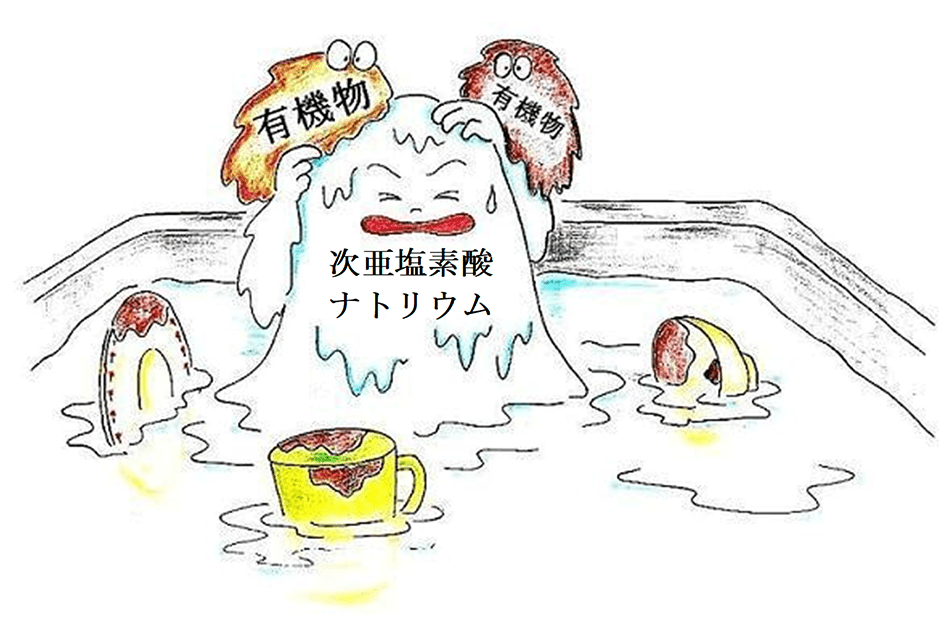新型コロナウイルスやSARSコロナウイルスなどによる環境汚染に対しては、0.05(500ppm)~0.1%(1,000ppm)次亜塩素酸ナトリウムや62~80vol%エタノールが推奨されています1-15)。これらの報告などから、COVID-19対策として0.05~0.1%濃度を用いるのであれば、次亜塩素酸ナトリウム希釈液での拭き取りは有効と推定されます。しかし、この濃度の次亜塩素酸ナトリウムで清拭を行うと、マンシェットの退色が生じる可能性があります。したがって、マンシェットには消毒用エタノールでの清拭や、70℃での熱水洗濯(外すことができる場合)などが勧められます。これらの方法はマンシェットの清潔保持に有効です16)。
次亜塩素酸ナトリウムの使用濃度について
次亜塩素酸ナトリウムはすべての微生物に有効な消毒薬です。ただし、本薬は汚れ(有機物)により効力が大幅に低下する特性を有しています(イラスト)。このため、本薬の使用では消毒対象の汚れの程度、使用法(清拭法or浸漬法)および対象微生物などによって用いる濃度が異なってきます。汚れが予想される場合、清拭法での使用の場合、芽胞やエンベロープのないウイルスが対象の場合などでは高めの濃度設定となります。たとえば、経管栄養剤の投与セットには0.01%(100ppm)液への1時間浸漬、ポータブルトイレのバケツには0.1%液への30分間浸漬、ノロウイルス汚染の環境には0.1%液での清拭、ディフィシル菌(芽胞)汚染の環境には0.1~1%(10,000ppm)液での清拭、ウイルス汚染血液には1%液での清拭などです。
なお、新型コロナウイルスはエンベロープを有するため消毒薬が効きやすいウイルスですが、重要なウイルスなのでノロウイルスの場合と同等の濃度を用いるのが望ましいです。

- 引用文献
-
- Song JY, et al: Viral shedding and environmental cleaning in Middle East respiratory syndrome coronavirus infection. Infect Chemother, 47: 252-255, 2015.
- Fung C-P, et al: Rapid creation of a temporary isolation ward for patients with severe acute respiratory syndrome in Taiwan. Infect Control Hosp Epidemiol, 25: 1026-1032, 2004.
- Rice EW, et al: Chlorine inactivation of highly pathogenic avian influenza virus (H5N1). Emerg Infect Dis, 13: 1568-1570, 2007.
- Tan Y-M, et al: Management of inpatients exposed to an outbreak of severe acute respiratory syndrome (SARS). J Hosp Infect, 58: 210-215, 2004.
- Kariwa H, et al: Inactivation of SARS coronavirus by means of povidone-iodine, physical conditions and chemical reagents. Dermatology, Suppl 1: 119-123, 2006.
- Rabenau HF, et al: Efficacy of various disinfectants against SARS coronavirus. J Hosp Infect, 61: 107-111, 2005.
- Wu S, et al: Environmental contamination by SARS-CoV-2 in a designated hospital for coronavirus disease 2019. Am J Infect Control, 48: 910-914, 2020.
- Tyler R, et al: Virucidal activity of disinfectants: studies with the poliovirus. J Hosp Infect, 15: 339-345, 1990.
- CDC: Disaster Safety: Infection control recommendations for prevention of transmission of diarrheal diseases in evacuation centers. September 10, 2005
- Jimenez L, et al: Virucidal activity of a quaternary ammonium compound disinfectant against feline calicivirus: A surrogate for norovirus. Am J Infect Control, 34: 269-273, 2006.
- Tung G, et al: Efficacy of commonly used disinfectants for inactivation of human noroviruses and their surrogates. J Food Prot, 76: 1210-1217, 2013.
- Sattar SA: Microbicides and the environmental control of nosocomial viral infections. J Hosp Infect, 56: S64-S69, 2004.
- Vonberg RP, et al: Infection control measures to limit the spread of Clostridium difficile. Clin Microbiol Infect, 14: 2-20, 2008.
- Kampf G, et al: Persistence of coronaviruses on inanimate surfaces and their inactivation with biocidal agents. J Hosp Infect, 104: 246-251, 2020.
- 大久保 憲,他:消毒と滅菌のガイドライン2020年版.へるす出版,2020.
- Matsuo M, et al: Contamination of blood pressure cuffs by methicillin-resistant Staphylococcus aureus and preventive measures. Ir J Med Sci, 182: 707-709, 2013.
